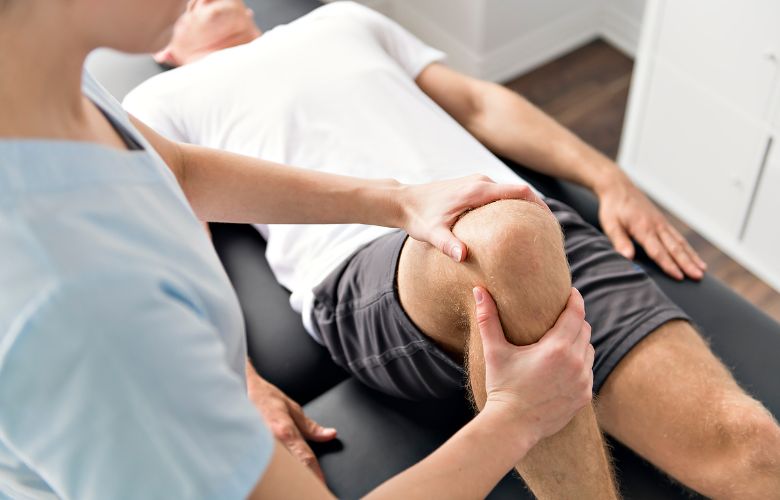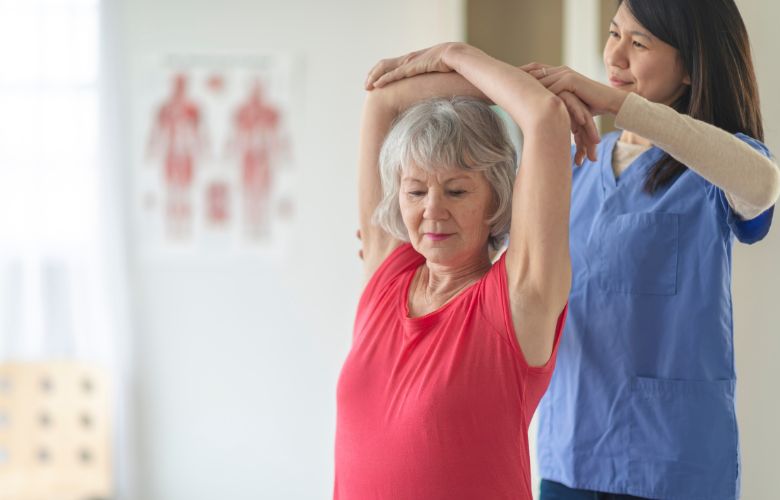The potential of physical activity for helping people to manage their pain is just one of the many advantages it has been found to have for overall health and well-being. Exercise and movement can actually assist relieve discomfort and enhance function, despite the fact that it may seem paradoxical to do so when in pain. Something that, unfortunately, a lot of people have to deal with today is some kind of chronic pain. There are various areas that can be affected by pain, but the most common one tends to be around the joints like hips and knees, but it can also be experienced in the head, neck, shoulders, and back. No matter what kind of pain you may have, physical activity might be the solution you are looking for.
⇒ Easing The Pain From Hip Arthritis Click Now
How Does Chronic Pain Impact Activity?

An individual’s capacity to engage in routine activities including walking, bending, and standing may be affected by chronic pain. This restriction is frequently brought on by the fact that chronic pain lasts longer than the typical healing time, which harms the body’s pain signalling system. In turn, this might result in elevated degrees of pain in response to even minor stimuli and pain hypersensitivity. As a result, tasks that were once simple for people with chronic pain might now be uncomfortable and difficult. Furthermore, persistent discomfort might cause a decline in physical fitness, which can make the issue worse.
For example, someone with persistent back pain, for instance, could refrain from exercising out of concern that it will make their pain worse. However, this might result in a loss of cardiovascular fitness, muscle strength, and flexibility, making it more challenging for the person to exercise and manage their pain over time. Chronic pain can have an impact on a person’s attitude and motivation to exercise in addition to having physical restrictions. Anxiety, despair, and exhaustion are frequently experienced by people with chronic pain, and these emotions can lower their desire to engage in physical exercise. These mental health issues can result in an endless loop where pain prevents action, which then contributes to a decline in mood and motivation, making it even more difficult to engage in physical activity in the future.
How Can Physical Activity Benefit Those With Chronic Pain?

Many studies have shown that there are various general health benefits from physical activity, and dealing with chronic pain is one of them. Physical therapy has been so effective that there are various clinics that will be providing these sessions to their patients instead of medication, as they are more effective. For example, you can get physiotherapy for back pain at Parramatta if you are in the area. The way that physical activity helps with chronic pain because it boosts brain health, helps with weight management, and helps reduce the burden caused by various diseases that cause that pain. It also helps strengthen muscles and bones, and with all those factors combined, chronic pain gets reduced quite fast. Lately, physical therapy is embraced so much that it is applied to all kinds of chronic conditions even where the pain is not present. Patients with heart diseases, diabetes, hypertension, and even some forms of cancer have shown improvement in their health after boosting their bodies with physical activity.
Should You Try Some Specific Physical Activities?

How To Get Started?

If you are not sure where to start, you should try and pick something from each category of physical activity, which has been shown to be effective in managing pain. It’s important to note that the type of physical activity that is most beneficial for an individual with pain may vary depending on the underlying cause and location of the pain. However, some specific physical activities that can help individuals deal with pain include:
- Aerobic Exercise: Aerobic exercise refers to any physical activity that raises the heart rate and breathing rate, such as cycling, jogging, swimming, or walking. Engaging in regular aerobic exercise has been proven to offer a plethora of health benefits, including pain relief. This is because aerobic exercise triggers the release of endorphins, which are the body’s natural painkillers, thereby reducing pain levels. Additionally, it enhances cardiovascular health, strengthens muscles, and uplifts mood, all of which can contribute to pain relief. For individuals with chronic pain, it is advisable to begin with low-impact activities and gradually increase the intensity as tolerated.
- Strength Training: Strength training is a type of exercise that involves using resistance to build muscle strength and tone. This can be achieved through various methods such as weightlifting, resistance band training, or bodyweight exercises. By strengthening muscles, individuals can improve joint support and reduce pain while also increasing mobility. Additionally, stronger muscles can help alleviate pressure and stress on joints, leading to further pain relief. It’s important to start with lighter weights and gradually increase as strength improves to avoid injury and maximize results.
- Stretching: Stretching is an essential part of any exercise routine, as it helps to improve flexibility and range of motion. Whether you prefer yoga, Pilates, or other stretching exercises, the benefits are numerous. By stretching and lengthening your muscles, you can reduce stiffness and pain in your joints, while also improving your posture and balance. It’s important to perform stretching exercises slowly and gently, without bouncing or overstretching your muscles, to avoid injury and get the most out of your workout.
- Tai Chi: Tai chi is a gentle form of exercise that originated in China and combines slow, fluid movements with deep breathing. It is based on the principles of martial arts and is a mind-body practice that has been shown to be effective in reducing pain levels and improving physical function in individuals with chronic pain. Tai chi can help improve balance, flexibility, and relaxation, all of which can contribute to pain relief and overall well-being.
- Aquatic Therapy: Aquatic therapy, also known as water therapy, is a form of physical therapy that takes place in a pool or other water-based environment. This type of therapy is particularly beneficial for individuals with joint pain or limited mobility, as the buoyancy of the water reduces pressure on the joints and allows for a greater range of motion. Additionally, the resistance of the water provides a low-impact way to build strength and improve cardiovascular fitness. Studies have shown that aquatic therapy can be effective in reducing pain and improving physical function in individuals with chronic pain.
⇒ Visiting A Chiropractor Can Solve Various Pain Problems Click Now
Tips For Exercising Safely With Pain

To prevent worsening your pain or reinjuring yourself further if you have chronic pain, it’s crucial to exercise safely. Here are some suggestions on how to exercise safely when in pain:
- Consult With A Healthcare Professional: It’s always a good idea to consult with a healthcare professional before beginning a new exercise program, especially if you have any pre-existing medical conditions or injuries. A healthcare professional can work with you to create a personalized exercise plan that is safe and effective for your individual needs. Don’t hesitate to seek their guidance and expertise to ensure that you’re taking the best possible care of your body.
- Start Slow: It’s tempting to jump into a new exercise routine with both feet, but starting slow is key to avoiding injury and discomfort. Begin with low-intensity workouts and shorter durations, gradually increasing as your body adapts and becomes stronger. This approach will help you build a solid foundation for long-term success.
- Listen To Your Body: It’s important to tune in to your body while working out. If you feel any pain or discomfort, take a break and give your body a chance to rest. Ignoring these signals and pushing through the pain can lead to more serious injuries and worsen any existing discomfort. So, always listen to your body and take care of yourself during exercise.
- Use Proper Form And Technique: To avoid injury and maximize the benefits of exercise, it’s important to use proper form and technique. This means maintaining the correct posture, alignment, and movement patterns during each exercise. If you’re unsure about how to perform a particular exercise, consider seeking guidance from a qualified professional such as a personal trainer or physical therapist. They can help you learn the proper form and technique to ensure safe and effective workouts.
- Choose Low-Impact Exercises: If you are experiencing joint pain, it’s important to choose exercises that are gentle on your body. Low-impact exercises like walking, swimming, and cycling are great options because they put less stress on your joints. These activities can still provide a great workout while minimizing the risk of injury or exacerbating joint pain.
- Incorporate Rest Days: It’s important to give your body time to rest and recover after exercise. Incorporating rest days into your workout routine can help prevent injury and reduce muscle soreness. Make sure to schedule rest days to give your body the time it needs to repair and recharge.
- Use Pain Management Techniques: If you are experiencing pain during exercise, don’t let it discourage you from staying active. There are a variety of pain management techniques that can help make exercise more tolerable. Applying heat or cold therapy, getting a massage, or taking over-the-counter pain relievers are all effective ways to alleviate pain and discomfort. By incorporating these techniques into your routine, you can continue to exercise and improve your overall health and well-being.
The Role Of Physical Therapy In Pain Management

For people with chronic pain, physical therapy can be a very effective non-invasive, drug-free method of pain management. Physical therapists are skilled at diagnosing, managing, and resolving pain and functional limitations caused by a wide range of illnesses and injuries, including musculoskeletal trauma, neurological disorders, and chronic pain syndromes.
The role of physical therapy in pain management includes:
- Evaluation and Assessment: To examine and analyze a patient’s pain and functional limits, physical therapists apply a range of instruments and approaches. In order to discover any underlying diseases or injuries that might be causing the pain, they may start by performing a comprehensive medical history and physical examination. In order to examine a patient’s movement patterns and spot any weak or unbalanced areas, they may also employ specialized movement analysis tools. To help identify the pain’s cause, imaging procedures like X-rays and MRIs may be employed. The physical therapist will create an individual treatment plan based on the patient’s unique requirements once the cause of the pain has been determined.
- Pain Management Techniques: If you’re experiencing pain, a physical therapist can help you manage it through a variety of techniques. One such technique is manual therapy, which involves hands-on techniques like massage or joint mobilization to reduce pain and improve mobility. Another option is to use modalities like heat or cold therapy to reduce inflammation and pain. Finally, therapeutic exercises like stretching, strengthening, and cardiovascular conditioning can help reduce pain and improve overall function. With the help of a physical therapist, you can find the right combination of techniques to manage your pain and improve your quality of life.
- Patient Education: Patient education is a crucial aspect of physical therapy, as it empowers patients to take an active role in their own healing process. Physical therapists provide valuable guidance on how to manage pain and prevent further injury. They may offer advice on proper posture, body mechanics, and ergonomics, as well as teach patients techniques for managing pain at home. This may involve using ice or heat therapy, practicing relaxation techniques, and following a personalized exercise program. Additionally, physical therapists may provide education on the importance of self-care and injury prevention, and offer guidance on nutrition and healthy lifestyle habits to support overall wellness.
- Exercise and Rehabilitation: Exercise and rehabilitation programs are essential for individuals recovering from injuries or surgeries. Physical therapists create personalized programs that target specific areas of weakness, such as strength, flexibility, and mobility. These programs may include a range of exercises, from stretching and strengthening to balance training and functional activities. The physical therapist will work closely with the patient to ensure that the program is tailored to their needs and abilities, and will monitor progress closely to make any necessary adjustments. With dedication and hard work, patients can regain their strength and mobility and return to their daily activities.
- Prevention and Maintenance: Prevention and maintenance are key components of physical therapy. Physical therapists collaborate with patients to create plans that prevent future injuries and maintain the progress achieved during treatment. This may involve educating patients on proper body mechanics and ergonomics, as well as providing exercises and stretches that can be performed at home to maintain strength and flexibility. Additionally, physical therapists may suggest regular check-ins to evaluate progress and modify the treatment plan as needed.
Final Word
It can be difficult to get back into exercising when you are experiencing some kind of chronic pain. However, while you may have a rocky start as the pain will make exercising inconvenient, you will notice that after a few weeks, all the exercises that you struggled with in the beginning are exceptionally easy to complete and that the pain you had is reduced significantly, or completely gone.
Recommended:
» How Visiting a Chiropractor Can Help You Say Goodbye to Pain
» 5 Natural Ways to Ease the Pain from Hip Arthritis
» Eye Pain: Symptoms, Causes, and Treatment Options


